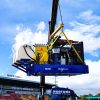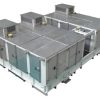High Pressure CO2 Injection Pumps
We have been designing and manufacturing pump systems for subsea injection duties for 25 years. Indeed, we were at the forefront of drill cuttings re-injection where we developed the technology alongside the offshore operators. High pressure CO2 injection is simply the continuation of our journey.
Typical CO2 injection pump pressures required to maintain its supercritical state are very similar to both produced water injection and drill cuttings re-injection. The flow rates for carbon dioxide injection can be considerably higher and our range includes numerous pumps capable of continuous duty at high flows. Special metals are used in the construction of pumps when they are exposed to harsh process liquids. Material selection suitable for the corrosive effects of CO2 ensures the pump’s reliable operation and longevity. Integrated heaters help maintain the necessary temperature of the liquefied carbon, preventing it from transitioning back to a gaseous state.
Our extensive experience in hazardous area applications ensures that our equipment adheres to the highest offshore energy sector standards. Safety and reliability are the cornerstones of our designs, instilling confidence in offshore operators. Read about pump selection for CO2 Injection in Carbon Sequestration.
Pipeline Support Pumps
Hydrate Inhibitor Injection
Hydrate formation is a significant concern when transporting carbon dioxide through pipelines. Hydrates can form under high pressure and low-temperature conditions, leading to pipeline blockages and flow disruptions.
This hydrate control pump skid featured a large integral methanol storage tank, ATEX Zone 2 hazardous area rating, and is suitable for high ambient temperature operation.
Corrosion Inhibitor Injection
CO2 is mildly acidic when dissolved in water, and this can lead to corrosion of pipeline materials. Corrosion can reduce the pipeline’s structural integrity, potentially causing leaks and affecting the carbon flow.
Corrosion inhibitor is just one of many applications for our chemical injection pump packages.
Well Start-up
Our product supply history includes MEG and Glycol pump skids for subsea valve actuation during well start-up operations. As with all of our energy pump packages, these can be designed for hazardous areas such as ATEX Zone 1 and NORSOK.
A Typical Offshore Injection Project
A typical project for an offshore injection pump package starts with the conceptual design/FEED phase. Our engineering team are here to provide assistance. They ensure the correct selection and the best use of the latest pumping technology to suit the application. Then the design stage. Our engineering team possesses vast experience in the field of offshore injection pumps. The build phase is next. Our build teams are experienced engineers accustomed to high specification projects. Then we move into one of the test bays. Of huge importance to our customers is our substantial test facilities where packages undergo comprehensive testing. The testing is frequently witnessed by the customer – either in person or through our remote factory acceptance test system. Involved throughout the process are our project management and documentation teams. Both teams play their part in ensuring compliance with the required industry and customer standards and regulations. All design, build and testing is carried out at our factory in Worcester, UK. Then we support you for the lifetime of the equipment with training, spares, and service.
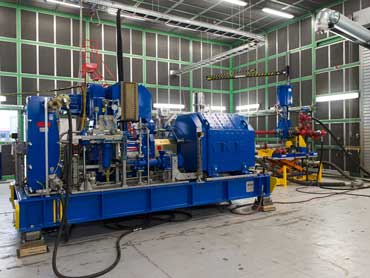
CO2 Injection Pump Design
Modular and Compact Injection Pumps
Where existing infrastructure is used to house the pump system, space is generally limited. The addition of a high pressure CO2 pump system was usually not part of the original design process for offshore platforms! Over the last decade, we have seen an increasing requirement for pump packages destined for challenging locations. We have, therefore, completed many projects for offshore platforms with limited access and space. Where there is simply limited space in the operating location, compact injection pump unit design is a skill we have honed well. Modular units are ideal where access is limited. The pump packages are built here, diss-assembled, and them re-assembled at their final destination.
Check out this video case study – Pump Skid for Existing Platform .
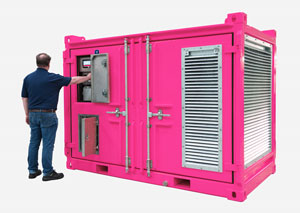
Diesel Engine or Electric Motor
Given the drive towards offshore electrification, it is no surprise that many of our offshore pump skids are powered by energy-efficient electric motors. For this reason, our test bays have the supply capability to test up to 1.8 MW and 10 kV. However, diesel driven pumps still have their place, especially in areas where there is either no electric supply, or the supply is unreliable.
Pump Unit Mounting
The options are:
- Skid. This is the lightest option. Skid units have fork-truck slots and we supply a lifting frame where required.
- Skid and separate environmental enclosure. This is a popular option for many of our customers. It consists of a lightweight skid with the option of a floor- or skid-mounted environmental enclosure with noise attenuation options.
- Crash frame. This option is lightweight and affords considerable protection during transportation.
- Container. This provides maximum protection from transportation operations and environmental conditions. Comes with a choice of noise attenuation options.
- Trailer. There are two trailer options for land-based operations. Firstly, operators use road-going trailer units for multi-site operations. Secondly, we offer site trailer units allowing easy movements within one site.
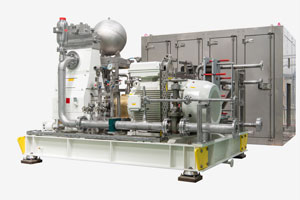
Contact Us
Whatever your high pressure CO2 pump application, we are here to help. Please call us on +44 1905 751790 or email sales@calder.co.uk to discuss how we can help you achieve your CCS targets.


